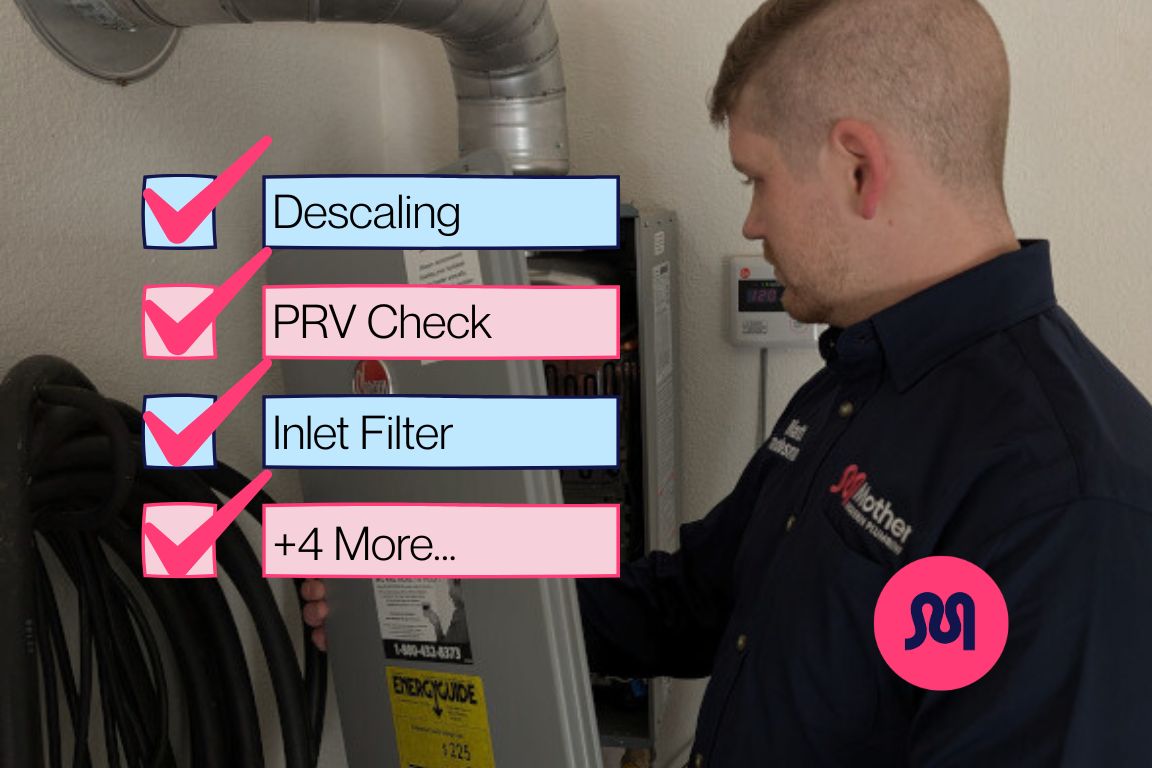PFAS in Water: Are DFW Water Suppliers Doing Enough?

table of contents
table of contents
You've probably read about the $420 million lawsuit Fort Worth filed against 3M, DuPont and the US Government. Perhaps you've seen a spike in PFAS levels in your city's recent water report. Either way, you've got really serious questions about forever chemicals in your drinking water.
Our local plumbing and water quality experts spent the last month researching news, data and public water system reports about PFAS in Dallas-Fort Worth's water supply.
We also spoke to the City of Keller, TX Public Works Director, about what his city is doing to protect its residents from PFAS contamination in tap water.
Worried about exposure to forever chemicals? Clean up your drinking water supply with a whole home water filtration system. Our master plumbers install home water filters throughout the DFW Metroplex.
{{whole-home-water-filtration="/services/whole-home-water-filtration"}}
11 DFW Water Systems Violate New EPA PFAS Limits

New environmental regulations can be difficult to adopt — especially when your water supply has decades’ worth of forever chemical contamination.
The EPA published national drinking water regulations for PFAS in April 2024 — and cities across Texas failed the grade.
49 Texas public water utilities reported levels of PFAS chemicals above EPA limits. 11 of those water systems are in the Dallas-Fort Worth Metroplex alone:
- Arlington Pierce Burch Water Treatment Plant
- City of Farmers Branch
- Dallas Water Utility Eula Water Supply Cooperation in Clyde
- Duncanville Water Treatment Plant
- Town of Flower Mound Wastewater Treatment
- Fort Worth North and South Holly Water Treatment Plant
- Grapevine Water Treatment Plant
- Haltom City
- Irving MacArthur Pump Station
- City of Lake Worth
- Weatherford Water Treatment Plant
Local cities must respond to new EPA regulations for PFAS
Public water systems have until 2027 to complete initial monitoring reports for 6 PFAS chemicals that are now regulated by the EPA. Cities like Keller, Texas, are getting an early jump on reporting forever chemical levels.
“Keller currently tests for 10 unregulated contaminants and is working with Trinity River Authority (TRA) to identify locations and producers of PFAS,” says Keller Public Works Director Alonzo Liñán.
“As we move toward 2027 deadlines, we’ll be working with our water supply partners to ensure that Keller’s water supply remains in compliance with federal water quality standards.”
Until 2027, it’s up to homeowners to fight PFAS. Mother Modern Plumbing offers proven in-home water treatment systems to remove chemical contaminants from your water.
The Unavoidable Truth of PFAS Exposure
PFAS is shorthand for perfluoroalkyl and polyfluoroalkyl substances. You know them better as “forever chemicals” — because they just don’t break down in the human body.
In fact, CDC studies show that forever chemicals are in the bloodstream of 97% of Americans.
PFAS have been everywhere since the 1950s. DFW residents are consistently exposed to these forever chemicals thanks to military, manufacturing and chemical plant use near our water supplies.
But PFAS are also used in an incredible variety of household products — from Teflon to microwave popcorn bags, cosmetics to waterproof clothing.
Forever chemicals present grave public health risks
Local city health officials say the dangers of PFAS contamination in water are very real.
“We’d encourage residents, first and foremost, to educate themselves about these chemicals and their risks,” Liñán told us.
The EPA’s current understanding of PFAS risks to human health includes the following:
PFAS Exposure: Health Risks in Adults
- Decreased fertility in pregnant women
- Increased risk of prostate, kidney, and testicular cancers
- Weakened immune system
- Interference with the body’s natural hormones
- Increased cholesterol levels
- Increased obesity risk
PFAS Exposure: Health Risks in Children
- Low birth weight
- Accelerated puberty
- Weakened immune system
- Bone development variations
- Behavioral and mood changes
- Increased obesity risk
These health risks aren’t long-term, “down the road” problems. In less than 2 years, forever chemicals in drinking water decimated a collection of Texas farmers and wildlife.
What are the PFAS levels in your city's drinking water? Learn how to read a DFW water quality report and look up how cities like Dallas, Fort Worth, Grapevine and Arlington rate for forever chemical contamination.
{{dallas-fort-worth-water-quality-report="/blogs/dallas-fort-worth-water-quality-report"}}
How PFAS Destroyed Johnson County, Texas
In December 2022, a Johnson County farmer complained his neighbor was using fertilizer that filled his property with smoke.
Two years later, Johnson County Commissioner Larry Woolley reported the death of hundreds of local livestock, cattle, horses and fish — and widespread illness among local residents.
When water samples were taken from the area, the results were shocking. Current EPA limits for regulated PFAS sit at 4 parts per trillion (ppt).
The Johnson County, Texas water samples measured between 91 ppt and 268 ppt.
These conditions lead Johnson County to declare an official state of disaster. They also prompted the City of Fort Worth to prematurely end its relationship with Synagro, the fertilizer company at the center of it all.
Fort Worth tries to escape Johnson County’s fate
The City of Fort Worth abruptly ended its 10-year contract with Synagro in the wake of PFAS concerns. It paid $2.4 million in settlements to leave the contract early.
Fort Worth also sued the U.S. Department of Defense, 3M and DuPont for $420 million in damages related to water contamination from PFAS.
“The City of Fort Worth has filed a lawsuit… to hold them accountable for contaminating Fort Worth’s drinking water sources,” city spokesperson Reyne Telles said in a statement.
The Response from Fort Worth’s Water Supply Partners

Other DFW municipalities are watching the proceedings in Fort Worth closely — especially cities like Keller, whose public water supply is interconnected with Fort Worth’s.
Keller purchases 238 million gallons of water from Fort Worth each month.
That means the fate of Keller’s water supply (and other towns like it) does largely rest in the hands of Fort Worth’s water treatment efforts.
Recent reports from the Environmental Working Group (EWG) show that Keller and Fort Worth test positive for virtually identical groups of water contaminants.
Cities like Keller, TX are taking proactive steps
Despite the sheer volume of water coming from Fort Worth, cities like Keller take an active approach to combat forever chemicals in their drinking water.
“Among our recent investments, we completed construction of the new Alta Vista Pump Station at the end of 2019,” Alonzo Liñán remarks about Keller’s infrastructure upgrades.
“That facility replaced one more than 40 years old, and it’s responsible for supplying about 70% of the city’s water, connecting our water source in Fort Worth to the lines that serve our residents.”
Liñán says the new interconnected system helps deliver clean water to customers. If one water treatment plant tests positive for PFAS, water from a different plant can be delivered to Keller.
Local Public Water Suppliers Grapple With Regulations
Public water suppliers are often hesitant to make concrete statements about PFAS contamination and testing results. This is to be expected, as EPA guidelines are quite new and the requirements for PFAS reporting are highly specific.
As major water supply companies search for answers to become EPA compliant, they face immediate challenges from forever chemicals in their water systems.
DWU water treatment in compliance, but Dallas still has PFAS in water
Dallas Water Utilities (DWU) began PFAS sample collection in 2023. Early reports show that all 3 DWU water treatment plants are currently in compliance with EPA forever chemical standards.
But that doesn’t mean the City of Dallas is PFAS-free. Not all of Dallas’ potable water comes from DWU. And 2 of the EPA’s regulated forever chemicals — PFOS and PFOA — were found in the city’s water supply.
The 2023 City of Dallas Water Quality Report notes a maximum PFOS level of 5.1 ppt and a maximum PFOA level of 6.3 ppt. Both of these levels exceed the EPA limit of 4.0 ppt.
One NTMWD water treatment plant has possible PFAS issues
The North Texas Municipal Water District (NTMWD) indicates they’re conducting a “holistic evaluation of [their] water, wastewater, and solid waste systems”.
While most testing results show compliance with current PFAS standards, NTMWD does note “action may be required at our Tawakoni Water Treatment Plant”, which sources water from Lake Tawakoni.
The Tawakoni Water Treatment Plant serves DFW cities like Allen, Forney, Plano, Richardson and Wylie.
Don’t wait for public water suppliers to get it right. Let our expert DFW plumbers show you how to choose a home water filter that removes forever chemicals from your tap.
{{how-to-choose-a-whole-house-water-filtration-system="/blogs/how-to-choose-a-whole-house-water-filtration-system"}}
The Texas Research Teams Fighting Against PFAS

Some of Texas’ brightest minds are tackling PFAS contamination with innovative research and in-depth studies.
At Texas A&M, Aggie researchers are looking for organic ways to break down forever chemicals faster. And local scientists took the first measurements of PFAS in the Arroyo Colorado watershed, looking for clues on how to combat contamination.
Texas A&M makes major headway in PFAS remediation
Scientists at Texas A&M AgriLife Extension are working on a natural solution to forever chemical contamination in our environment.
Their research aims to use fungal and plant-based materials to speed up the breakdown of PFAS compounds in drinking water.
According to Texas A&M, their approach can “successfully bind PFAS at higher concentrations than other currently available sorbents, and that the fungus can remove more than 98% of PFAS after two weeks of treatment”.
The EPA awarded the Texas A&M researchers $1.6 million towards this intriguing research.
New PFAS contamination found in Arroyo Colorado watershed
Scientists from Texas A&M and Texas Water Resources Institute (TWRI) traveled to the Arroyo Colorado watershed to study the impact of PFAS in the region.
The Arroyo Colorado watershed is located in the Rio Grande Valley, on the Mexico border near South Padre Island. Water flows from the watershed to Lower Laguna Madre on the Gulf of Mexico.
The research team found PFAS in 29 of 30 samples taken. It reflects the immediate impact that rapid urbanization and growth have on sensitive watershed areas — and how quickly PFAS contamination occurs in water.
DFW Homeowners Can Protect Themselves From PFAS
Despite the urgency of PFAS-related health risks, Texas public water suppliers have until 2027 to complete initial PFAS testing.
And public water systems have until 2029 to implement solutions for PFAS violations.
Until then, it’s up to homeowners to get forever chemicals out of their drinking water. Advocates like Keller’s Public Works Director Alonzo Liñán urge DFW residents to learn as much as possible about PFAS.
“The EPA offers some great educational materials about PFAS, as well as tips to reduce exposure, up to and including installing a certified in-home water treatment filter,” Liñán suggests.
“As Fort Worth adapts to the new regulations and their upcoming deadlines, we’ll be sharing their findings with water customers.”
Take control of the fight against PFAS. Get forever chemicals out of your home with a whole house water filtration system. Call Mother for a free consultation.
{{whole-home-water-filtration="/services/whole-home-water-filtration"}}




